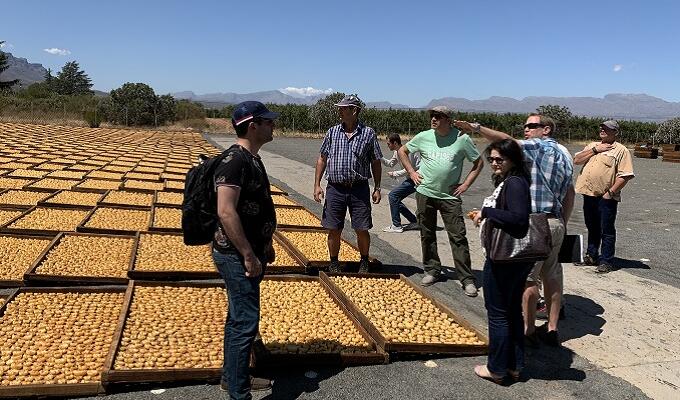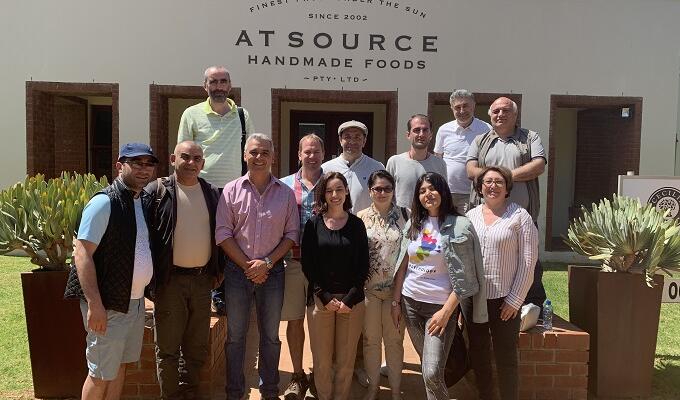


From ancient Armenia to modern South Africa: mastering the secrets of dried fruit
Dried fruit producers from Armenia were impressed by the expertise and streamlined production methods they saw in South Africa on a study tour in March 2020. During the trip, the Armenian producers learned first-hand about the entire production process from cultivation at fruit farms to processing and sales − techniques they could apply back in Armenia.
Around 100 types of dried fruit products are exported worldwide from South Africa. With an annual production volume of up to 4,000 tons, the country is among the world’s leading producers of dried fruit and products made from dried fruit.
The study tour was organized by the ITC-implemented ‘Eastern Partnership: Ready to Trade – an EU4Business Initiative’ funded by the European Union. The project helps small and medium-sized enterprises to produce value-added goods in line with international market standards. It links them with buyers from global markets, in particular in the European Union.
In South Africa, the Armenian producers had a chance to visit farms, factories and retailers, as well as attend business meetings to explore the best international practices in the sector.
‘Having the right farm and the right crop is key in dried fruit production,’ Ara Marutyan, the founder of Agrolog Educational Production Centre, said.
‘In South Africa, this sector is regulated by special laws; for example, the producers must use the crop specifically meant for dried fruit production. More than 15 years is required to cultivate a single fruit species for dried fruit production. In South Africa, the whole crop is brought to the same standard in terms of its size, firmness and colour,’ he said.
During the study tour, the Armenian producers gained expert advice on manufacturing internationally and specifically on products that are competitive in the European Union. Such knowledge included how to obtain accurate moisture levels, extend shelf-life, produce attractive yet affordable packaging in line with the European standards and marketing tips for boosting sales.
To diversify sources of income and ensure the effective use of resources, South African dried fruit producers also produce an array of value-added dried fruit products, such as fruit bars and candies, for both domestic consumption and export.
‘This tour convinced us even further how important it is to produce dried fruit products in addition to dried fruit itself,’ Ara Khachikyan, head of Armenian company Sateni, said.
‘We’re already brainstorming that idea.’
Mastering the secrets
The success of the South African dried fruit producers is also rooted in education. Masters in Food Production are only given a degree after creating a new food product. And the degree is only awarded after at least 100 people have tasted the product and provided positive feedback.
In South Africa, there are also special associations that serve as a valuable link between the state and producers. They help producers enhance their capacity in dried fruit production and contribute to the overall advancement of the sector by providing consultancy services on fruit species, competitiveness and exports. The associations also provide state bodies with suggestions on taxation, state support and other issues. Their viability is ensured by its members who pay 21 cents for each kilogram of dried fruit and 10 cents for each kilogram of fresh fruit sold.
To ensure quality products, dried fruit producers in South Africa also use simple but effective tricks.
For instance, sounds of wild birds and gunshots are played through loudspeakers to drive away birds preying on mesh trays with dried fruit. Another key to success is the efficient use of natural resources. Each farm has a reservoir to collect rain and snowmelt water for irrigation. Leftover peach stones are even used to spruce up garden paths.
Nairi Margaryan, production control and external relations officer of Armenian company Ritea, said it would be quite feasible to apply the South African experience back home.
Lida Devejyan, deputy director of Armenian company Arcolad said she believes that cooperation and coordinated work is at the core of the success of South African dried fruit producers.
The practice of drying fruit in Armenia dates back centuries. In the 5th century BCE, the Greek historian Herodotus mentioned the sun-kissed dried fruit that was transported by Armenian merchants along with wine and other products. Xenophon of Athens described the dried fruit that Armenian peasants had stored for winter.
Drying fruit such as apricots, pears, apples, peaches and plums remains common in modern Armenia mainly due to the passion of producers and the country’s favourable climate.
As part of ‘Eastern Partnership: Ready to Trade – an EU4Business Initiative’, Armenian producers have participated in leading trade shows in Europe to establish new business ties and enhance their export potential.
Thanks to the consultancy services of international and local experts, many beneficiaries are on their way to obtaining HACCP (Hazard analysis and critical control points) certification, which is a valuable business card for accessing European and US markets.
Armenia’s State Revenue Committee reported exports of 263 tons of dried fruit and vegetables in 2018; in 2019, this figure had almost doubled to 485 tons.
According to Tigran Tsaturyan, head of the processing department of the Organic Armenia Association, cultivation on designated farms, the introduction of new species of seedlings and the improvement of local ones, as well as creating young professional teams and transitioning to organic agriculture, will help Armenian producers maintain and improve this trend by making local produce more competitive in the international market.
About the EU4Business Initiative
The EU4Business Initiative covers all EU support for small and medium-sized enterprises (SMEs) in the region of the Eastern Partnership which brings together the EU, its member states and six partner countries: Armenia, Azerbaijan, Belarus, Georgia, Moldova and Ukraine.
This article was prepared with the assistance of Sona Tadevosyan.



